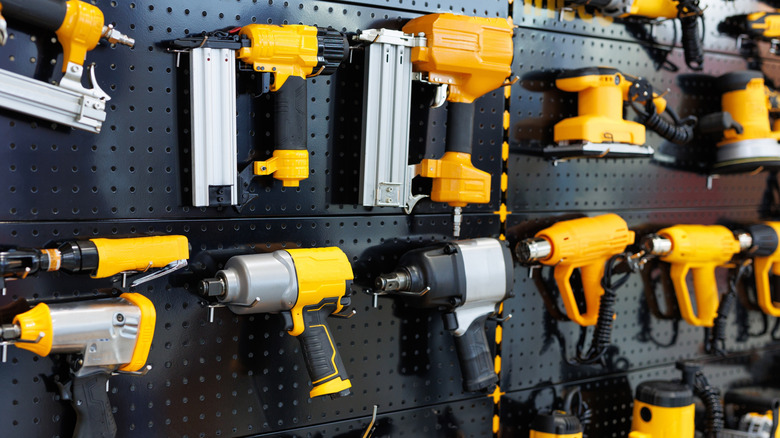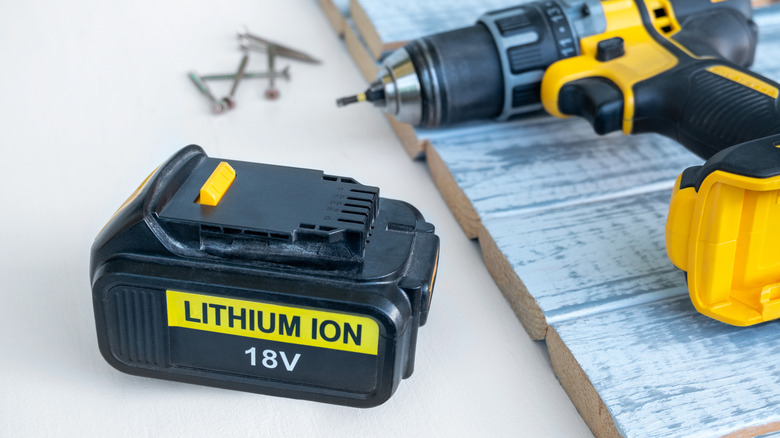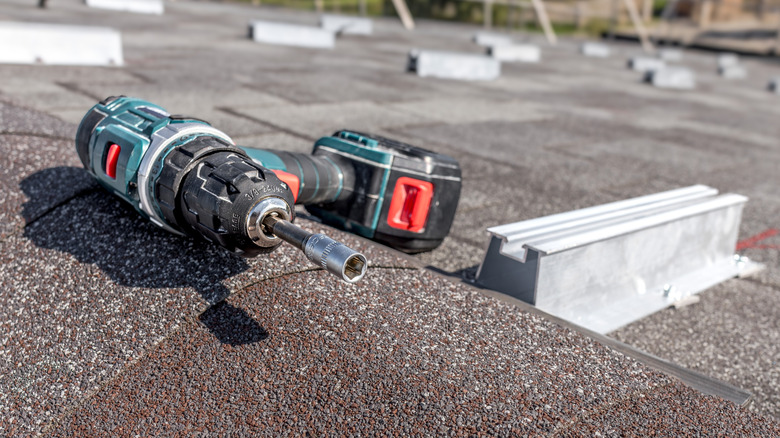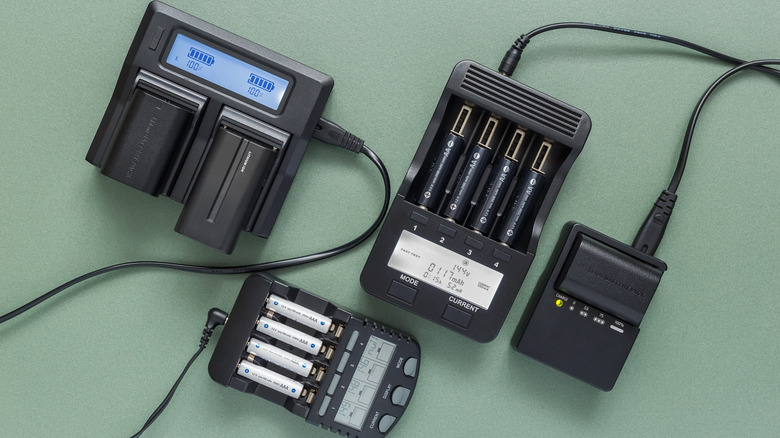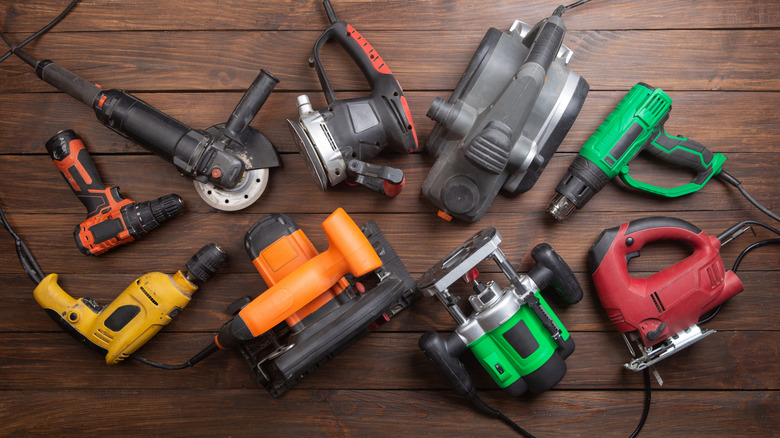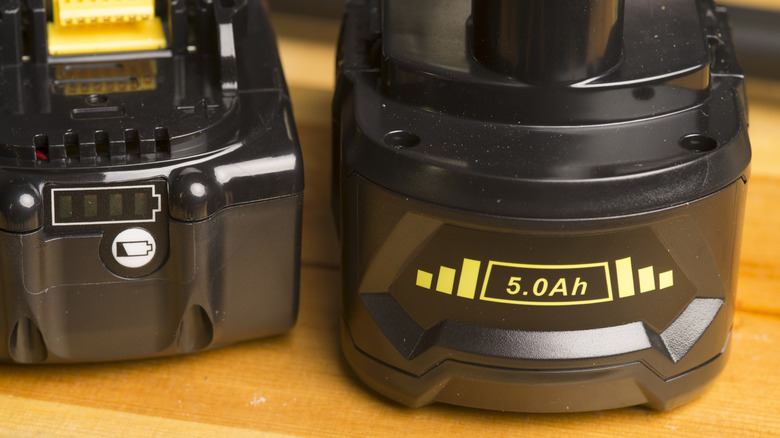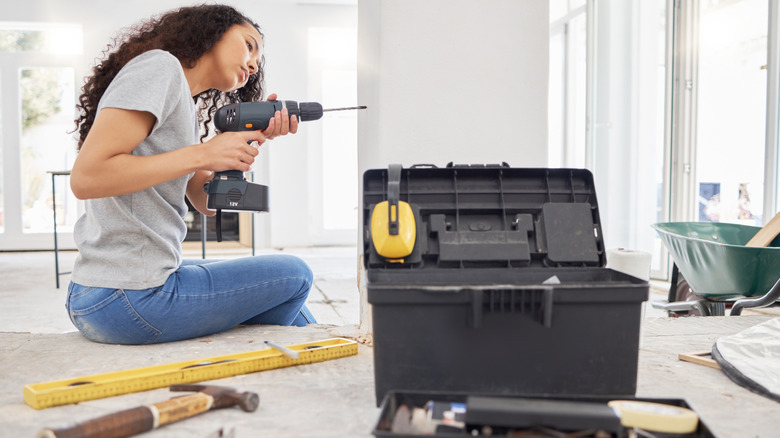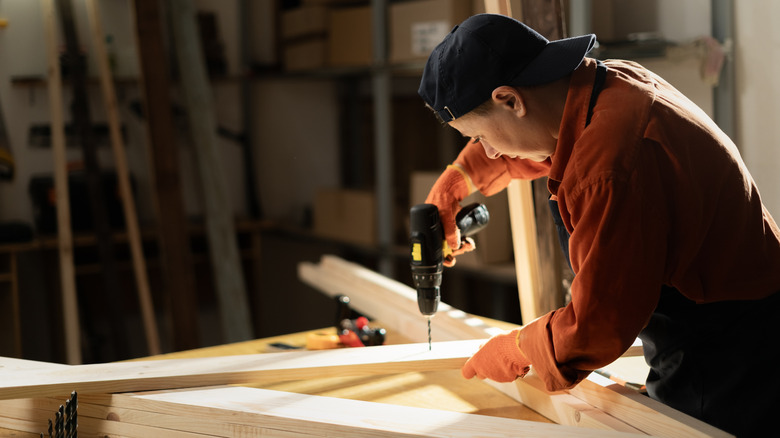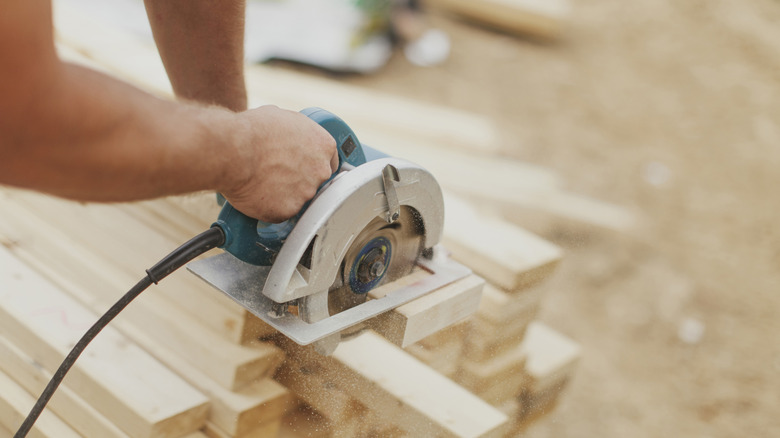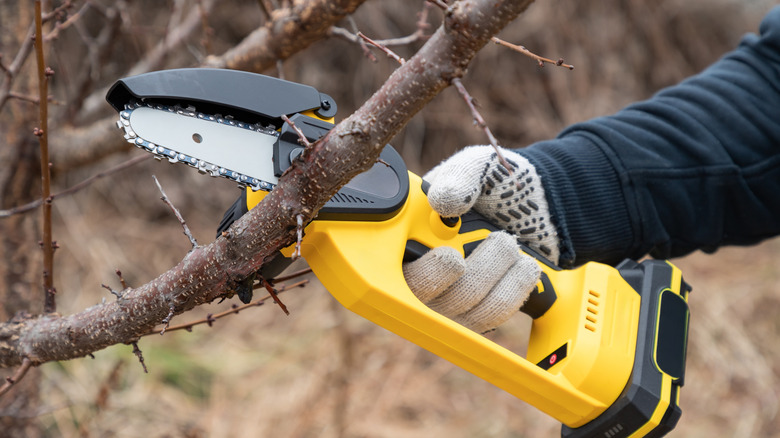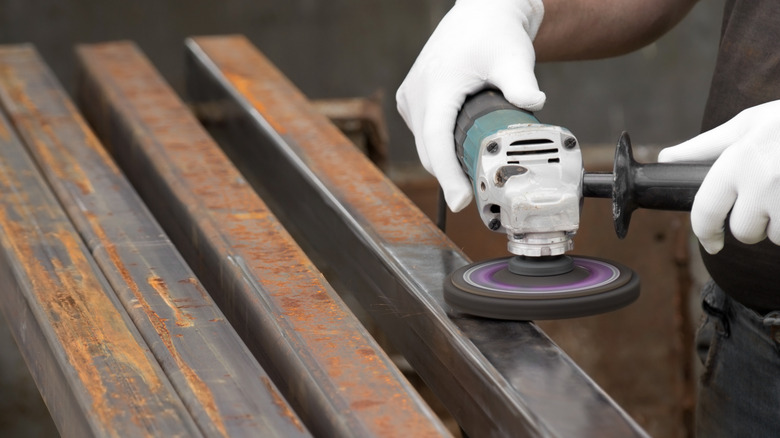10 Mistakes That Are Ruining Your Power Tool Batteries
Power tools make a litany of tasks so much simpler. Even something as simple as drilling becomes a breeze when you can let a machine do the bulk of the work. However, any power tool lives and dies by the quality of its battery — if that becomes damaged, you're basically left with a glorified screwdriver.
Whether you rely on power saws, angle grinders, orbital sanders, or anything else, you don't want to rely on a faulty battery. This includes regularly charging it so that you can be confident you can use all of your tools when an important job comes along. However, many people don't realize that certain everyday actions can significantly degrade the quality of said battery. Over time, you'll notice telltale signs a power tool battery requires replacement, which will only eat into your savings.
You're better off attempting to extend the life of your batteries by avoiding some common mistakes. You may have never even realized the following could be so harmful, which is why it's our duty to set everyone on a better path.
Overcharging
Some DIYers want to be absolutely certain their power tools are fully charged and ready to go before starting a new project. It's easy enough to let the battery charge indefinitely, but it's a good idea to keep an eye on your workstation. Many lithium batteries, which a lot of power tools use, can become overcharged, which causes the temperature within the battery cells to heat up and damage the interior components. Regular overcharging can drastically shorten a battery's lifespan, so it's always a good idea to take it off the charger once it's fully powered.
Granted, many brands insist you can leave batteries on the charger for extended periods of time without worrying about damage. For example, it's generally safe to leave Makita batteries on chargers because they contain maintenance modes that won't cause the internal cells to overheat. But even if you're not concerned about damaging the battery, it's still a good idea to monitor your batteries in case something else pops up.
Makita chargers come with a variety of LED lights to inform the user of the charging status. This lets you know when it's fully charged, but keeping an eye on it is also recommended in case there are any problems. The last thing you want is to think your battery is good to go, only to realize something went wrong, and it never charged in the first place.
Exposing batteries to extreme heat
Overcharging and excessively using a power tool can naturally cause the battery to heat up. But you're only adding fuel to the fire (no pun intended) when you excessively use your power tool in the blazing heat or simply leave the battery lying around in direct contact with sunlight. Much like overcharging, this can lead to the battery's cells gradually degrading, and you may even experience a thermal runaway fire.
Lithium-ion batteries are susceptible to chain reactions resulting in gas release and internal short-circuits. This results in battery cells rupturing, greatly increasing the chances of the whole thing exploding and causing a fire in the surrounding area. Therefore, it's a good idea to keep your power tool batteries stored in a cool location, particularly during the summer. And if you're done using an item for the day, you should put it away somewhere rather than keeping it out in the sun.
Protecting batteries from extreme elements extends into the other direction, too. You should store your power tools somewhere warm in the winter and the same goes for their accompanying batteries. Freezing temperatures can impact the chemicals within the batteries and make them less effective. The presence of snow and ice also increases the chances of water winding up in your batteries, which can also short-circuit the system.
Using the wrong charger
When regularly dealing with power tools, it's not just the batteries that'll die on you one day. The chargers themselves also degrade over time, eventually requiring replacement. Some folks may think it's easy enough to stick the battery on a different type of charger, especially if it's been marketed as a "universal" variety. By and large, you're always better off getting the exact specific charger that's compatible with the battery in question.
For instance, some may think it's possible to interchange the M12 and M18 Milwaukee power tools and chargers. That isn't the case, as M18 tools, batteries, and chargers are all meant to go with one another. The same holds true for M12 tools, which are lighter than the M18 variety and need a charger that can adequately accommodate that.
Even universal chargers aren't always safe, especially if they're off-brand. At best, they'll likely be ineffective at charging the battery all the way. At worst, they could completely kill the battery far sooner than anticipated. When a charger dies, it's paramount to get the exact same one from the manufacturer designed to charge the specific battery you have.
Storing dead batteries
A battery may be on its last legs right when you finish a job. It sounds simple enough to place it in storage until you need to use that tool again, which may not be for weeks or even months. Some may think it doesn't matter to charge a battery if it's just going in a cupboard for the time being, but storing dead power tool batteries might mean you won't be able to use that battery down the line.
Storing dead batteries can cause the internal cells to degrade, which means it's not going to last for as many charge cycles. Most lithium batteries are designed to last anywhere between 300 and 500 charge cycles, meaning it goes from uncharged to fully charged. If you let the battery go for long stretches completely empty, you may only get a fraction of those cycles.
The solution to this seems easy: When a battery is dead, simply charge it up all the way before it goes into storage. However, that can also lead to problems if you're not careful.
Storing a fully charged battery
When it comes to storing power tool batteries, the Goldilocks principle is at play. You don't want to put them away for an extended period of time when they're completely out of juice, but you also don't want to charge them to 100% and then let them sit idle.
The issue here is if you're storing the battery in a place where it may be exposed to high temperatures. A fully charged battery is more likely to explode when exposed to extreme heat, which in this case is anywhere that could get over 120 degrees Fahrenheit, so it's good to keep it in a place where it'll stay relatively cool.
Even if a battery pack manual claims it's safe to store a battery fully charged, you're generally better off if you leave them about 50% to 60% charged before putting them away. There's a good chance there will still be some power left in them when you need them again, and you'll have a reduced chance of a fire breaking out if you live in an area with particularly brutal summers.
Failing to keep batteries secure
When you're done using a power tool, it's recommended to remove the battery if that's an option. Leaving a battery inside means there will be some drain, so even if you have it half charged, there's a greater likelihood it'll be empty when you come back. This also limits the risk of the power tool accidentally turning on and damaging something or hurting someone when you're away.
However, when you remove the battery, you don't want to just toss it to the side, especially if you keep all your tool parts inside of a truck. All of the consistent moving and banging around can damage a battery, shortening its lifespan well below how long it should last. Ideally, you'll keep the original container the tool came in so that the battery remains secure. Barring that, you can get additional padded boxes to keep batteries in to give them extra cushioning as you drive around.
If you want to ensure your batteries remain viable, you can check their charge every couple of months. There shouldn't be too much power loss if they're kept in a cool, dry place that doesn't get exposed to any moisture.
Coming into contact with liquids
As is the case with any battery-powered device, you want to ensure your power tools stay dry at all times. This isn't always possible on a job site — someone may accidentally kick something into a puddle or a pool, or it may just begin to rain. Regardless, Ryobi batteries aren't waterproof, nor are batteries from many other brands, and you may not be able to salvage the part.
One of the worst mistakes you can do with a wet power tool battery is immediately plug it into a charger, but you may be able to save it when you immediately take it out of the tool after getting it wet. You should wipe off the battery as much as you can and then leave it out in a well-ventilated, warm area until it dries completely. You don't want to forcefully try to remove any moisture, as this could further damage any terminals or cells. When in doubt, consult with the power tool owner's manual to see if it has any other suggestions.
These steps only apply to batteries that come into contact with fresh water. Your battery's pretty much done if it gets submerged in saltwater, as this will corrode the metal terminals. Many warranties don't cover water damage, so do your best to ensure your batteries never get wet, even if it means postponing a project if it starts to drizzle.
Not giving your power tools a break
One of the most common problems with Ryobi batteries is overheating, and this is something to be aware of regardless of brand. By just naturally using a power tool, the battery will warm up and generate heat. You may feel the tool actually warming up throughout the course of its use, but ideally, it should never get hot to the point it's uncomfortable to hold. If that starts to happen, it's time to give your tool a break.
This is particularly important if you're working outside on an extremely hot day. The external temperature combined with the internal electricity warming up the battery could quickly make the tool unbearable to touch. Not only will this damage the battery's internal components, but the motor inside the tool itself could also begin to break down.
This is more likely to occur if you're using the power tool continuously on a particularly rough material, like trying to saw or drill through concrete. It's a good idea to take a break and let the tool and battery come down a few degrees before using them again. The manual should contain guidelines on recommended continuous usage.
Using the wrong battery for your tool
The phrase "If I fit, I sit" may apply to cats, but it doesn't work with power tool batteries. Just because a battery can work with a certain power tool doesn't mean you should use it, especially if it has inadequate voltage to properly power it. This could lead to the battery becoming unusable sooner than expected because it went through its maximum charge cycles more quickly. You may also wind up breaking the tool, or even causing the battery to overwork and eventually explode.
When a battery dies for a given power tool, you want to replace it with the exact same one recommended by the manufacturer. Some people may be tempted to opt for a knockoff brand that insists it's exactly the same as the big companies. Saving a few bucks might feel nice, but you can never be certain if a knockoff battery is capable of providing the voltage the tool needs.
Plus, the improper battery could cost you far more in the long run. If you think buying a new battery is expensive, just wait until you wind up needing a whole new power tool set because counterfeit batteries voided your warranties.
Coming into contact with metal
Keeping power tool batteries away from water should go without saying, but you also want to keep them away from any random metal objects, including small things like coins and nails. The reason for this is that the metal can act as a conducting point between the terminals inside the battery, causing a short circuit. This can damage the mechanisms and make the battery unusable, or even create a fire. It's best not to risk anything and simply keep your power tool batteries separate from anything else when not in use.
All of these power tool battery mistakes may sound like overkill, but even if a battery isn't at a great risk of exploding, it's better to play it safe than sorry. Early in 2024, two major fires in Branch County, Michigan were caused by the misuse of lithium-ion batteries, including one that reportedly came from a charging power tool battery in an apartment complex's maintenance room.
Power tools are a great resource. They can make a litany of tasks so much simpler, but you need to know what you're doing, especially when it comes to handling the batteries. That way, you can be certain your tools will last as long as possible, and you can keep yourself and the people in your community safe.
